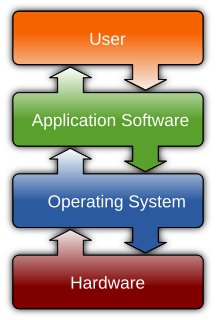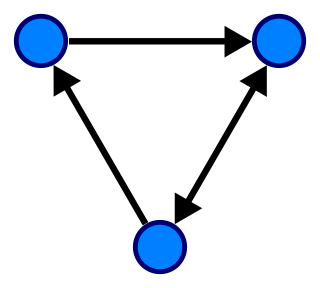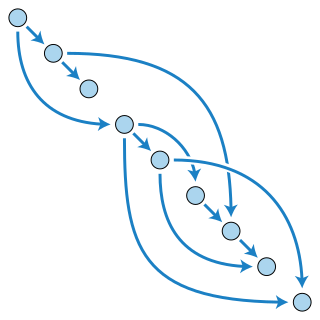In object-oriented programming, a class is an extensible program-code-template for creating objects, providing initial values for state and implementations of behavior. In many languages, the class name is used as the name for the class, the name for the default constructor of the class, and as the type of objects generated by instantiating the class; these distinct concepts are easily conflated.

The Open Systems Interconnection model is a conceptual model that characterizes and standardizes the communication functions of a telecommunication or computing system without regard to its underlying internal structure and technology. Its goal is the interoperability of diverse communication systems with standard protocols. The model partitions a communication system into abstraction layers. The original version of the model defined seven layers.

Design Patterns: Elements of Reusable Object-Oriented Software (1994) is a software engineering book describing software design patterns. The book's authors are Erich Gamma, Richard Helm, Ralph Johnson and John Vlissides with a foreword by Grady Booch. The book is divided into two parts, with the first two chapters exploring the capabilities and pitfalls of object-oriented programming, and the remaining chapters describing 23 classic software design patterns. The book includes examples in C++ and Smalltalk.

A scene graph is a general data structure commonly used by vector-based graphics editing applications and modern computer games, which arranges the logical and often spatial representation of a graphical scene.
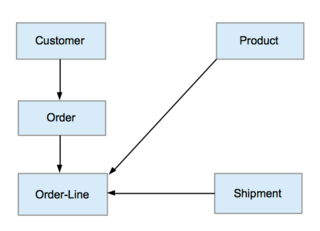
The network model is a database model conceived as a flexible way of representing objects and their relationships. Its distinguishing feature is that the schema, viewed as a graph in which object types are nodes and relationship types are arcs, is not restricted to being a hierarchy or lattice.
A hierarchical database model is a data model in which the data are organized into a tree-like structure. The data are stored as records which are connected to one another through links. A record is a collection of fields, with each field containing only one value. The type of a record defines which fields the record contains.

In computing, a visual programming language (VPL) is any programming language that lets users create programs by manipulating program elements graphically rather than by specifying them textually. A VPL allows programming with visual expressions, spatial arrangements of text and graphic symbols, used either as elements of syntax or secondary notation. For example, many VPLs are based on the idea of "boxes and arrows", where boxes or other screen objects are treated as entities, connected by arrows, lines or arcs which represent relations.
DOT is a graph description language. DOT graphs are typically files with the file extension gv or dot. The extension gv is preferred to avoid confusion with the extension dot used by early (pre-2007) versions of Microsoft Word.
Open service interface definitions (OSIDs) are programmatic interface specifications describing services. These interfaces are specified by the Open Knowledge Initiative (O.K.I.) to implement a service-oriented architecture (SOA) to achieve interoperability among applications across a varied base of underlying and changing technologies.
The Authorization Open Service Interface Definition (OSID) is an O.K.I. specification which provides the means to define who is authorized to do what, when. OSIDs are programmatic interfaces which comprise a Service Oriented Architecture for designing and building reusable and interoperable software.
The Filing Open Service Interface Definition (FOSID) is an Open Knowledge Initiative specification. OSIDs are programmatic interfaces which comprise a service-oriented architecture for designing and building reusable and interoperable software.
Freebase was a large collaborative knowledge base consisting of data composed mainly by its community members. It was an online collection of structured data harvested from many sources, including individual, user-submitted wiki contributions. Freebase aimed to create a global resource that allowed people to access common information more effectively. It was developed by the American software company Metaweb and ran publicly beginning in March 2007. Metaweb was acquired by Google in a private sale announced 16 July 2010. Google's Knowledge Graph was powered in part by Freebase.
In computing, a graph database (GDB) is a database that uses graph structures for semantic queries with nodes, edges and properties to represent and store data. A key concept of the system is the graph, which directly relates data items in the store a collection of nodes of data and edges representing the relationships between the nodes. The relationships allow data in the store to be linked together directly, and in many cases retrieved with one operation. Graph databases hold the relationships between data as a priority. Querying relationships within a graph database is fast because they are perpetually stored within the database itself. Relationships can be intuitively visualized using graph databases, making it useful for heavily inter-connected data.
Apache ZooKeeper is a software project of the Apache Software Foundation. It is essentially a centralized service for distributed systems to a hierarchical key-value store, which is used to provide a distributed configuration service, synchronization service, and naming registry for large distributed systems. ZooKeeper was a sub-project of Hadoop but is now a top-level Apache project in its own right.
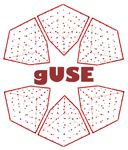
The Grid and Cloud User Support Environment (gUSE), also known as WS-PGRADE /gUSE, is an open source science gateway framework that enables users to access grid and cloud infrastructures. gUSE is developed by the Laboratory of Parallel and Distributed Systems (LPDS) at Institute for Computer Science and Control (SZTAKI) of the Hungarian Academy of Sciences.
Node graph architecture is a type of software design which builds around modular node components which can be connected to form a graph. Often the software's underlying node graph architecture is also exposed to the end user as a two-dimensional visualization of the node graph. The node graph architecture is popular in the film and computer games industry.
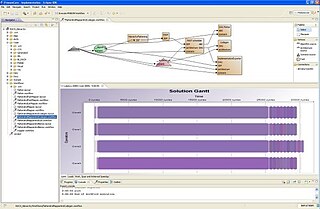
PREESM is an open-source rapid prototyping and code generation tool. It is primarily employed to simulate signal processing applications and generate code for multi-core Digital Signal Processors. PREESM is developed at the Institute of Electronics and Telecommunications-Rennes (IETR) in collaboration with Texas Instruments France in Nice.

Sones GraphDB was a graph database developed by the German company sones GmbH, available from 2010 to 2012. Its last version was released in May 2011. sones GmbH, which was based in Erfurt and Leipzig, was declared bankrupt on January 1, 2012.

Apache Storm is a distributed stream processing computation framework written predominantly in the Clojure programming language. Originally created by Nathan Marz and team at BackType, the project was open sourced after being acquired by Twitter. It uses custom created "spouts" and "bolts" to define information sources and manipulations to allow batch, distributed processing of streaming data. The initial release was on 17 September 2011.

